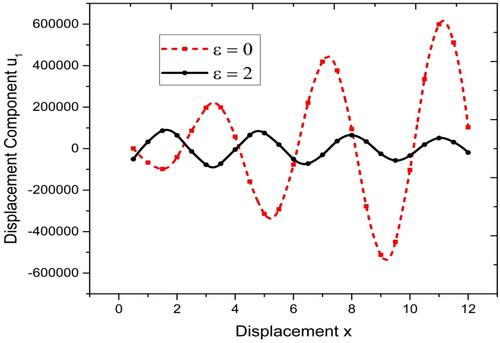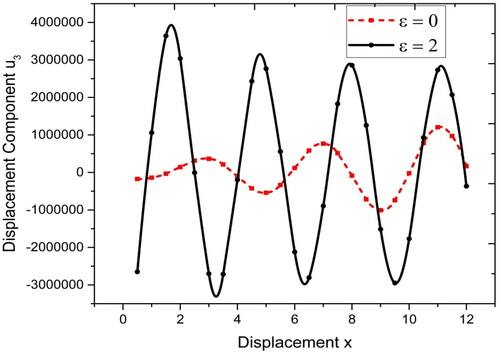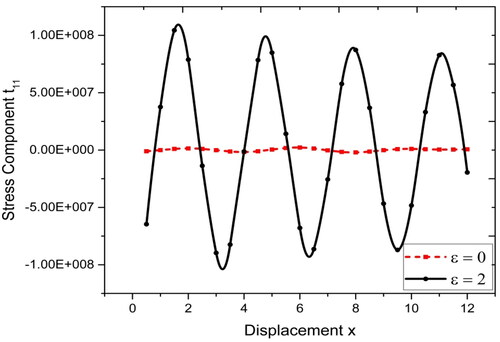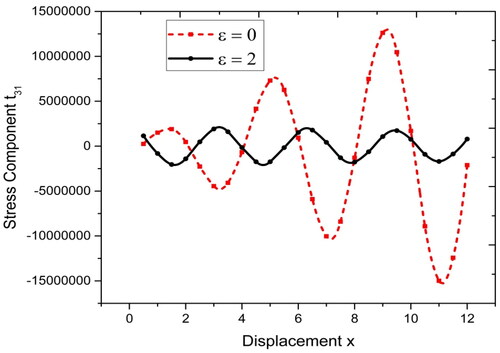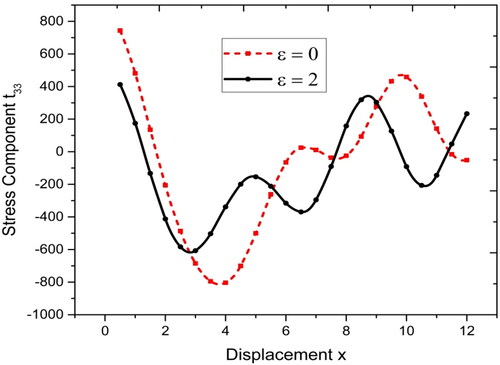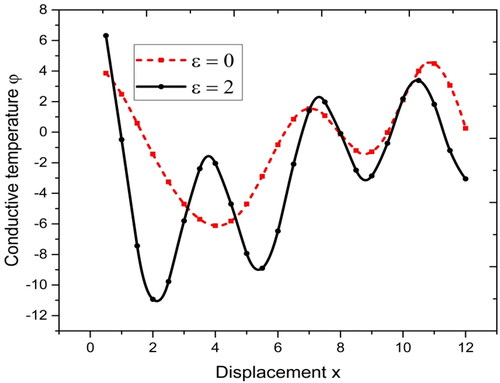 ?Mathematical formulae have been encoded as MathML and are displayed in this HTML version using MathJax in order to improve their display. Uncheck the box to turn MathJax off. This feature requires Javascript. Click on a formula to zoom.
?Mathematical formulae have been encoded as MathML and are displayed in this HTML version using MathJax in order to improve their display. Uncheck the box to turn MathJax off. This feature requires Javascript. Click on a formula to zoom.Abstract
This investigation is focused on the effects of nonlocality due to 2-D deformations arising in a nonlocal homogeneous isotropic thermoelastic solid which is subjected to a ramp type heat source with two temperature. There has been the use of Laplace and Fourier transforms for solving the equations. The expressions for displacement components, stress components and conductive temperature have been computed in the transformed domain. The numerical inversion technique has been used for obtaining the results in the physical domain. The effect of nonlocal parameter on the displacement components, conductive temperature and stress components have been represented graphically.
1. Introduction
The nonlocal theory of thermoelasticity considers that the various physical quantities are not just dependent upon the values of independent constitutive variables at that point only but upon those values for the whole system. Nonlocal effects are of dominant nature. Also, if the effects of strains at points other than the reference point are not considered then the results obtained are similar to the results of the classical theory. In the theory of thermoelasticity with two temperatures, the heat conduction is dependent upon the variations on two distinct temperatures; one of these is the conductive temperature while the other is thermodynamic temperature.
A Continuum theory for elastic materials was developed by Kroner (Citation1967) for long range cohesive forces and proved the importance of range effects. A theory of nonlocal interactions was derived by Edelen and Laws (Citation1971) agreeing to the concept of nonlocality as suggested by Kroner. Edelen, Green, and Laws (Citation1971) obtained the constitutive equations for the theory of nonlocal elasticity termed as protoelasticity. Eringen and Edelen (Citation1972) developed the nonlocal elasticity theory by making use of the global balance laws and the second law of thermodynamics. Wang and Dhaliwal (Citation1993) established a reciprocity relation and addressed certain issues addressing nonlocal thermoelasticity and extended the concept of nonlocality further. Artan (Citation1996) proved the superiority of nonlocal theory by comparing various results of both theories. The uniqueness results were derived by Marin (Citation1997) for thermoelastic bodies with voids.
Polizzotto (Citation2001) further refined the Eringen model of nonlocal elasticity theory. Eringen (Citation2002) developed nonlocal continuum field theories. Paola, Failla, and Zingales (Citation2010) presented a mechanical based approach to three-dimensional nonlocal elasticity theory and proved the high dependence of the results on the size. Simsek (Citation2011) conducted a study for studying the influences of the nonlocal parameter. The problem of generalized thermoelasticity was discussed by Zenkour and Abbas (Citation2014). Marin and Nicaise (Citation2016) studied the thermoelastic behavior of dipolar bodies. Vasiliev and Lurie (Citation2016) discussed different nonlocal elasticity theories. Marin and Craciun (Citation2017) described that the nonlocal effects are shown by the micro-structured composites.
Khetir, Bouiadjra, Houari, Tounsi, and Mahmoud (Citation2017) worked on the nanosized FG plates and proposed a new nonlocal deformation theory. Marin, Baleanu, and Vlase (Citation2017) investigated the theory of micropolar thermoelastic bodies. Hassan, Marin, Ellahi, and Alamri (Citation2018) studied the convective heat transfer. Bachher and Sarkar (Citation2018) studied the theory of non-locality for thermoelastic materials having voids. Lata (Citation2018a) discussed nonlocality effects for plane waves and Lata (Citation2018b) continued the study in thermoelastic medium having sandwich layer. Lata and Singh (Citation2019) studied the nonlocality effects for inclined load.
Chen and Gurtin (Citation1968) investigated the heat conduction theory for the involvement of two temperatures. Youssef (Citation2006) constructed a new theory in which the heat conduction theory for deformable bodies was considered. He gave the concept of dependence on two distinct temperatures. Abbas and Youssef (Citation2009) analyzed the transient phenomena and proposed a new model for thermoelastic solids. Youssef and Al-Lehaibi (Citation2010) further constructed a new model for elastic materials. Abbas and Youssef (Citation2013) took this analysis further. Abbas (Citation2014) extended this study to a spherical cavity. Carrera, Abouelregal, Abbas, and Zenkour (Citation2015) studied the effect of two temperatures for a beam under the effects of a ramp type heat source. Kumar, Sharma, and Lata (Citation2016a) investigated the disturbances under the combined effects of rotation, two temperature, Hall currents and magnetic field. Kumar, Sharma, and Lata (Citation2016b) studied thermomechanical interactions under the effects of a rotating medium with magnetic effect and two temperature.
Ezzat, El-Karamany, and El-Bary (Citation2016a) used a Kernel function for constructing a new model for thermoelastic materials while Ezzat and El-Bary (Citation2016) did it for thermo viscoelastic materials. Ezzat and Ai-Bary (Citation2017) gave a mathematical model which was based on fractional derivative heat transfer. Ezzat, El-Karamany, and El-Bary (Citation2018) applied the memory-dependent derivatives to derive a model of magneto-thermoelasticity. Ezzat and El-Bary (Citation2017) derived a new mathematical model based on two temperature theory along with fractional heat transfer. Lata and Singh (Citation2020a) investigated the nonlocal parameter effects with hall current for a magneto-thermoelastic solid due to normal force and studied the effects of nonlocality on various components graphically.
Lata and Singh (Citation2020b) studied the two temperature and nonlocal parameter effects on a homogeneous isotropic thermoelastic material in a frequency domain. Chen, Lin, and Wang (Citation2019), Fang and Dai (Citation2020), Wu and Dai (Citation2020) and Wang, Lu, Dai, and Chen (Citation2020) studied and investigated the Soliton solutions for nonlinear Schrodinger equations and discussed the diffraction effects, different nonlinear effects, evolution of optical wave etc. Abbas (Citation2016) studied a thermoelastic body with a spherical cavity subjected to a thermal shock in the context of the theory of fractional order thermoelasticity and proved that the fractional parameter effect plays a significant role on all the physical quantities. Ezzat, El-Karamany, and El-Bary (Citation2016b) developed a new mathematical model for magneto-thermoelastic materials with two temperature and showed the effects on various physical quantities. Abouelregal and Ahmad (Citation2020) constructed a fractional thermoelastic modified Fourier’s law. Abo‐Dahab, Abouelregal, and Ahmad (Citation2020) gave a thermoelastic model of fractional order and used it to discuss a problem of thermoelastic half‐space. Abdel-Khalek, Abo-Dahab, Ragab, Ahmad, and Rawa (Citation2020) studied the dynamical behavior of the geometric phase based on the engineering of a three-level atomic configuration and the effect of energy dissipation of the dynamical properties of the geometric phase.
Here, in this paper the effects of nonlocality and two temperature in a homogeneous isotropic nonlocal homogeneous thermoelastic solid under ramp type heat source have been discussed and the effects on the displacement components, stress components and conductive temperature have been computed numerically and depicted graphically.
2. Basic equations
Following Youssef (Citation2006) and Eringen (Citation2002), the equations of motion and the constitutive relations for a homogeneous isotropic nonlocal thermoelastic solid with two temperature are given by
(1)
(1)
(2)
(2)
where
(3)
(3)
(4)
(4)
where
is the nonlocal parameter,
is the conductive temperature,
corresponds to the mass density, the displacement vector corresponds to
=(
is two temperature parameter,
is reference temperature while
is thermodynamic temperature,
is the specific heat,
is the thermal conductivity coefficient,
where
are material constants and
is thermal expansion coefficient,
corresponds to strain tensor components,
is dilatation,
is the Kronecker delta and
are the stress tensor components.
3. Formulation of the problem
A nonlocal homogeneous isotropic thermoelastic solid is considered in an initially undeformed state at temperature We take a rectangular Cartesian co-ordinate system
with
-axis pointing normally into the half-space, which is thus represented by
We consider the plane such that all particles on a line parallel to
-axis are equally displaced, so that the field components
and
and
are independent of
We restrict our analysis to two-dimensional problem i.e.,
(5)
(5)
Using EquationEquation (5)(5)
(5) in EquationEquations (1)
(1)
(1) and Equation(2)
(2)
(2) , yields
(6)
(6)
(7)
(7)
(8)
(8)
where,
We define the following dimensionless quantities
(9)
(9)
where,
and
Upon introducing the quantities defined by EquationEquation (9)(9)
(9) in EquationEquations (6)–(8)
(6)
(6) , and suppressing the primes, yields
(10)
(10)
(11)
(11)
(12)
(12)
Introducing potential functions defined by
(13)
(13)
where,
and
are scalar potential functions.
Using EquationEquation (13)(13)
(13) in EquationEquations (10)–(12)
(10)
(10) , and applying Laplace and Fourier transforms defined by
(14)
(14)
(15)
(15)
On the resulting equations, a system of homogeneous equations is obtained as follows,
(16)
(16)
(17)
(17)
(18)
(18)
where,
and
The system of EquationEquations (16)–(18)(16)
(16) , will have a nontrivial solution if the determinant of coefficient
is vanished to give characteristic equations as
(19)
(19)
(20)
(20)
where,
and
The roots of EquationEquation (19)(19)
(19) are
and of (Equation20
(20)
(20) ) are
which are obtained by using the radiation conditions that
as
Then the solutions of these equations are written as,
(21)
(21)
(22)
(22)
(23)
(23)
where,
3.1. Boundary conditions
The boundary conditions are given by:
(24)
(24)
(25)
(25)
The boundary of the half-space is affected by ramp-type heating, which depends upon co-ordinate and time t of the form
(26)
(26)
where,
is dirac delta function of
while
is a function defined as follows:
(27)
(27)
where
corresponds to the length of the time required to raise the heat while
is a constant. It means that the boundary of the half space is at a fixed temperature
and at rest initially. Then it is suddenly raised to a temperature which is equal to a function
and then is maintained at this temperature.
Laplace and Fourier transforms are applied to both sides of (26) so that we get,
(28)
(28)
where
By making use of the dimensionless quantities defined by (Equation9(9)
(9) ), with the aid of (Equation4
(4)
(4) ), (Equation14
(14)
(14) )–(Equation15
(15)
(15) ) and (Equation21
(21)
(21) )–(Equation23
(23)
(23) ), the displacement components, stress components and conductive temperature are obtained
(29)
(29)
(30)
(30)
(31)
(31)
(32)
(32)
(33)
(33)
(34)
(34)
4. Particular cases
If
then from EquationEquations (29)–(34)
(29)
(29) , the corresponding expressions for displacement components, stress components and conductive temperature for nonlocal homogeneous isotropic solid without effect of two temperature are obtained.
For
= 0, the corresponding expressions for isotropic solid without nonlocal effects and with two temperature are obtained from EquationEquations (29)–(34)
(29)
(29) .
5. Inversion of the transformation
For obtaining the solution in physical domain, the transforms in EquationEquations (29)–(34)(29)
(29) are to be inverted. The conductive temperature and the components for displacement and stresses are functions of
and
respectively and thus of the form
So, for obtaining the function
in the physical domain, the Fourier transform will be inverted using
(35)
(35)
where
and
are the odd and even parts of
respectively. So that EquationEquation (35)
(35)
(35) gives the Laplace transform
of the function
Now, the Laplace transform function
can be inverted to
using Honig and Hirdes (Citation1984). Then, the integral in EquationEquation (35)
(35)
(35) is to be calculated. The method as prescribed in Press, Teukolshy, Vellerling, and Flannery (Citation1986) has been applied for evaluation of this integral. Romberg’s integration with adequate step size along with the results from successive refinements of the extended trapezoidal rule have also been utilized for this purpose.
6. Numerical results
Magnesium material has been selected for numerical calculations. The physical data for which is given as below:
A comparison of values w.r.t. distance has been made for the components of displacements, stresses and conductive temperature for local and nonlocal parameter
and is presented graphically in .
The solid line having black color with circles as center symbol corresponds to
The dotted red colored line with squares as center symbol corresponds to
From it is clearly visible that the variations of normal displacement for local and non local parameters are different. For
the variations are oscillatory and also there is an increase in upward and downward variations while for
the variations are oscillatory but with constant variations. From , it has been observed that for both local and nonlocal parameters, the variations of normal displacement
are different while for
the variations are less oscillatory for
and more oscillatory for
but for
the variations are oscillatory with more variations in the starting and with decreasing oscillations with increase in displacement. As evident from , for
the variations for normal stress follow high variation oscillatory path with slightly decreasing variations later but with almost a constant path with slight oscillations for
From , the variations of tangential stress
for local and nonlocal parameters have been shown as following oscillatory path. For
the variations are more oscillatory and with increasing magnitude of variations while for
the variations are oscillatory with almost constant magnitude of variations. In , the variations of normal stress
with displacement are shown. It is clear that the variations for both local as well as nonlocal parameters decrease for starting values of x, then increasing with small oscillations. The variations for local and nonlocal parameters are clearly distinct in the figure. Form . It is clear that the variations of conductive temperature
for local and nonlocal parameters are distinctive and oscillatory in nature. For
the variations are slightly less oscillatory in terms of magnitude of oscillations as compared to
7. Conclusion
In the above discussion the numerical results have been computed and depicted graphically showing the effects of nonlocal parameter on conductive temperature and the components of displacements and stresses. From the graphs, it is concluded that variations for different components is following oscillatory paths for most of the values of displacement but the variations are different for nonlocal and local parameter. It is observed that there is a significant impact due to the concept of nonlocality and thus the parameter cannot be ignored. The Ramp type heat source used in this investigation has shown clear variations for the local and nonlocal parameters. These results can be of utmost importance for the researchers in the field of material sciences, mechanics, geophysics, acoustics etc.
Disclosure statement
There is no conflict of interest with anyone.
References
- Abbas, I. A. (2014). Eigenvalue approach for an unbounded medium with a spherical cavity based upon two-temperature generalized thermoelastic theory. Journal of Mechanical Science and Technology, 28(10), 4193–4198. doi:10.1007/s12206-014-0932-6
- Abbas, I. A. (2016). Eigenvalue approach to fractional order thermoelasticity for an infinite body with a spherical cavity. Journal of the Association of Arab Universities for Basic and Applied Sciences, 20(1), 84–88. doi:10.1016/j.jaubas.2014.11.001
- Abbas, I. A., & Youssef, H. M. (2009). Finite element analysis of two-temperature generalized magneto-thermoelasticity. Archive of Applied Mechanics, 79(10), 917–925. doi:10.1007/s00419-008-0259-9
- Abbas, I. A., & Youssef, H. M. (2013). Two-temperature generalized thermoelasticity under ramp-type heating by finite element method. Meccanica, 48(2), 331–339. doi:10.1007/s11012-012-9604-8
- Abdel-Khalek, S., Abo-Dahab, S. M., Ragab, M., Ahmad, H., & Rawa, M. (2020). Engineering entanglement, geometric phase and quantum Fisher information of a three-level system with energy dissipation. Mathematical Methods in the Applied Sciences. doi:10.22541/au.159144130.08996694.
- Abo‐Dahab, S. M., Abouelregal, A. E., & Ahmad, H. (2020). Fractional heat conduction model with phase lags for a half‐space with thermal conductivity and temperature dependent. Mathematical Methods in the Applied Sciences. 10.1002/mma.6764.
- Abouelregal, A., & Ahmad, H. (2020). A modified thermoelastic fractional heat conduction model with a single-lag and two different fractional-orders. Journal of Applied and Computational Mechanics. doi:10.22055/jacm.2020.33790.2287
- Artan, R. (1996). Nonlocal elastic half plane loaded by a concentrated force. International Journal of Engineering Science, 34(8), 943–950. doi:10.1016/0020-7225(95)00132-8
- Bachher, M., & Sarkar, N. (2018). Nonlocal theory of thermoelastic materials with voids and fractional derivative heat transfer. Waves in Random and Complex Media, 29(4), 595–613. doi:10.1080/17455030.2018.1457230.
- Carrera, E., Abouelregal, A. E., Abbas, I. A., & Zenkour, A. M. (2015). Vibrational analysis for an axially moving microbeam with two temperatures. Journal of Thermal Stresses, 38(6), 569–590. doi:10.1080/01495739.2015.1015837
- Chen, P. J., & Gurtin, M. E. (1968). On a theory of heat conduction involving two temperatures. Zeitschrift Für Angewandte Mathematik Und Physik Zamp, 19(4), 614–627. doi:10.1007/BF01594969
- Chen, S. J., Lin, J. N., & Wang, Y. Y. (2019). Soliton solutions and their stabilities of three (2 + 1)-dimensional PT-symmetric nonlinear Schro¨ dinger equations with higher-order diffraction and nonlinearities. Optik, 194, 162753. doi:10.1016/j.ijleo.2019.04.099
- Edelen, D. G. B., & Laws, N. (1971). On the thermodynamics of systems with nonlocality. Archive for Rational Mechanics and Analysis, 43(1), 24–35. doi:10.1007/BF00251543
- Edelen, D. G. B., Green, A. E., & Laws, N. (1971). Nonlocal continuum mechanics. Archive for Rational Mechanics and Analysis, 43(1), 36–44. doi:10.1007/BF00251544
- Eringen, A. C. (2002). Nonlocal continuum field theories. New York: Springer.
- Eringen, A. C., & Edelen, D. G. B. (1972). On nonlocal elasticity. International Journal of Engineering Science, 10(3), 233–248. doi:10.1016/0020-7225(72)90039-0
- Ezzat, M. A., & El-Bary, A. A. (2017). A functionally graded magnetothermoelastic half space with memory-dependent derivatives heat transfer. Steel and Composite Structures, 25(2), 177–186.
- Ezzat, M. A., El-Karamany, A. S., & El-Bary, A. A. (2018). Two-temperature theory in Green-Naghdi thermoelasticity with fractional phase lag heat transfer. Microsystem Technologies, 24(2), 951–961. doi:10.1007/s00542-017-3425-6
- Ezzat, M., & Ai-Bary, A. A. (2017). Fractional magneto-thermoelastic materials with phase lag Green-Naghdi theories. Steel and Composite Structures, 24(3), 297–307.
- Ezzat, M., El-Karamany, A., & El-Bary, A. (2016a). Generalized thermoelasticity with memory-dependent derivatives involving two temperatures. Mechanics of Advanced Materials and Structures, 23(5), 545–553. doi:10.1080/15376494.2015.1007189
- Ezzat, M., El-Karamany, A., & El-Bary, A. (2016b). Magneto-thermoelasticity with two fractional order heat transfer. Journal of the Association of Arab Universities for Basic and Applied Sciences, 19(1), 70–79. doi:10.1016/j.jaubas.2014.06.009
- Ezzat, M.A., & El-Bary, A.A. (2016). Magneto-thermoelectric viscoelastic materials with memory dependent derivatives involving two temperature. International Journal of Applied Electromagnetics and Mechanics, 50(4), 549–567. doi:10.3233/JAE-150131
- Fang, J. J., & Dai, C. Q. (2020). Optical solitons of a time-fractional higher-order nonlinear Schrödinger equation. Optik, 209, 164574. doi:10.1016/j.ijleo.2020.164574
- Hassan, M., Marin, M., Ellahi, R., & Alamri, S. Z. (2018). Exploration of convective heat transfer and flow characteristics synthesis by Cu–Ag/water hybrid-nanofluids. Heat Transfer Research, 49(18), 1837–1848. doi:10.1615/HeatTransRes.2018025569
- Honig, G., & Hirdes, U. (1984). A method for the numerical inversion of Laplace transform. Journal of Computational and Applied Mathematics, 10(1), 113–132. doi:10.1016/0377-0427(84)90075-X
- Khetir, H., Bouiadjra, M. B., Houari, M. S. A., Tounsi, A., & Mahmoud, S. R. (2017). A new nonlocal trigonometric shear deformation theory for thermal buckling analysus of embedded nanosize FG plates. Structural Engineering and Mechanics, 64(4), 391–402.
- Kroner, E. (1967). Elasticity theory of materials with long range cohesive forces. International Journal of Solids and Structures, 3, 731–742.
- Kumar, R., Sharma, N., & Lata, P. (2016a). Effects of Hall current in a transversely isotropic magnetothermoelastic two temperature medium with rotation and with and without energy dissipation due to normal force. Structural Engineering and Mechanics, 57(1), 91–103. doi:10.12989/sem.2016.57.1.091
- Kumar, R., Sharma, N., & Lata, P. (2016b). Thermomechanical interactions in the transversely isotropic magnetothermoelastic medium with vacuum and with and without energy dissipation with combined effects of rotation, vacuum and two temperatures. Applied Mathematical Modelling, 40(13–14), 6560–6575. doi:10.1016/j.apm.2016.01.061
- Lata, P. (2018a). Reflection and refraction of plane waves in layered nonlocal elastic and anisotropic thermoelastic medium. Structural Engineering and Mechanics, 66(1), 113–124.
- Lata, P. (2018b). Effect of energy dissipation on plane waves in sandwiched layered thermoelastic medium. Steel and Composite Structures, 27(2), 439–451.
- Lata, P., & Singh, S. (2019). Effect of nonlocal parameter on nonlocal thermoelastic solid due to inclined load. Steel and Composite Structures, 33(1), 123–131.
- Lata, P., & Singh, S. (2020a). Deformation in a nonlocal magneto-thermoelastic solid with hall current due to normal force. Geomechanics and Engineering, 22(2), 109–117.
- Lata, P., & Singh, S. (2020b). Time harmonic interactions in nonlocal thermoelastic solid with two temperatures. Structural Engineering and Mechanics, 74(3), 341–350.
- Marin, M. (1997). An uniqueness result for body with voids in linear thermoelasticity. Rendiconti di Matematica Roma, 17(7), 103–113.
- Marin, M., & Craciun, E. M. (2017). Uniqueness results for a boundary value problem in dipolar thermoelasticity to model composite materials. Composites Part B: Engineering, 126, 27–37. doi:10.1016/j.compositesb.2017.05.063
- Marin, M., & Nicaise, S. (2016). Existence and stability results for thermoelastic dipolar bodies with double porosity. Continuum Mechanics and Thermodynamics, 28(6), 1645–1657. doi:10.1007/s00161-016-0503-4
- Marin, M., Baleanu, D., & Vlase, S. (2017). Effect of microtemperatures for micropolar thermoelastic bodies. Structural Engineering and Mechanics, 61(3), 381–387. doi:10.12989/sem.2017.61.3.381
- Paola, M., Failla, G., & Zingales, M. (2010). The mechanically based approach to 3D non-local linear elasticity theory: Long-range central interactions. International Journal of Solids and Structures, 47(18–19), 2347–2358. doi:10.1016/j.ijsolstr.2010.02.022
- Polizzotto, C. (2001). Nonlocal elasticity and related variational principles. International Journal of Solids and Structures, 38(42–43), 7359–7380. doi:10.1016/S0020-7683(01)00039-7
- Press, W. H., Teukolshy, S. A., Vellerling, W. T., & Flannery, B. P. (1986). Numerical recipes in Fortran. Cambridge: Cambridge University Press.
- Simsek, M. (2011). Forced vibration of an embedded single-walled carbon nanotube traversed by a moving load using nonlocal Timoshenko beam theory. Steel & Composite Structures, 11(1), 59–76. doi:10.12989/scs.2011.11.1.059
- Vasiliev, V. V., & Lurie, S. A. (2016). On correct nonlocal generalized theories of elasticity. Physical Mesomechanics, 19(3), 259–269. doi:10.1134/S102995991603005X
- Wang, B. H., Lu, P. H., Dai, C. Q., & Chen, Y. X. (2020). Vector optical soliton and periodic solutions of a coupled fractional nonlinear Schrödinger equation. Results in Physics, 17, 103036. doi:10.1016/j.rinp.2020.103036
- Wang, J., & Dhaliwal, R. S. (1993). On some theorems in the nonlocal theory of micropolar elasticity. International Journal of Solids and Structures, 30(10), 1331–1338. doi:10.1016/0020-7683(93)90215-S
- Wu, G. Z., & Dai, C. Q. (2020). Nonautonomous soliton solutions of variable-coefficient fractional nonlinear Schrodinger equation. Applied Mathematics Letters, 106, 106365. doi:10.1016/j.aml.2020.106365
- Youssef, H. M. (2006). Theory of two-temperature-generalized thermoelasticity. IMA Journal of Applied Mathematics, 71(3), 383–390. doi:10.1093/imamat/hxh101
- Youssef, H. M., & Al-Lehaibi, E. A. (2010). Fractional order generalized thermoelastic half-space subjected to ramp-type heating. Mechanics Research Communications, 37(5), 448–452. doi:10.1016/j.mechrescom.2010.06.003
- Zenkour, A. M., & Abbas, I. A. (2014). A generalized thermoelasticity problem of an annular cylinder with temperature-dependent density and material properties. International Journal of Mechanical Sciences, 84, 54–60. doi:10.1016/j.ijmecsci.2014.03.016

